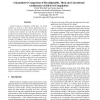Free Online Productivity Tools
i2Speak
i2Symbol
i2OCR
iTex2Img
iWeb2Print
iWeb2Shot
i2Type
iPdf2Split
iPdf2Merge
i2Bopomofo
i2Arabic
i2Style
i2Image
i2PDF
iLatex2Rtf
Sci2ools
FCCM
2004
IEEE
2004
IEEE
A Quantitative Comparison of Reconfigurable, Tiled, and Conventional Architectures on Bit-Level Computation
General purpose computing architectures are being called on to work on a more diverse application mix every day. This has been fueled by the need for reduced time to market and economies of scale that are the hallmarks of software on general purpose microprocessors. As this application mix expands, application domains such as bitlevel computation, which has primarily been the domain of ASICs and FPGAs, will need to be effectively handled by general purpose hardware. Examples of bit-level applications include Ethernet framing, forward error correction encoding/decoding,and efficient state machine implementation. In this paper we compare how differing computational structures such as ASICs, FPGAs, tiled architectures, and superscalar microprocessors are able to compete on bitlevel communication applications. A quantitative comparison in terms of absolute performance and performance per area will be presented. These results show that although modest gains (2-3x) in absolute performance c...
| Added | 20 Aug 2010 |
| Updated | 20 Aug 2010 |
| Type | Conference |
| Year | 2004 |
| Where | FCCM |
| Authors | David Wentzlaff, Anant Agarwal |
Comments (0)

